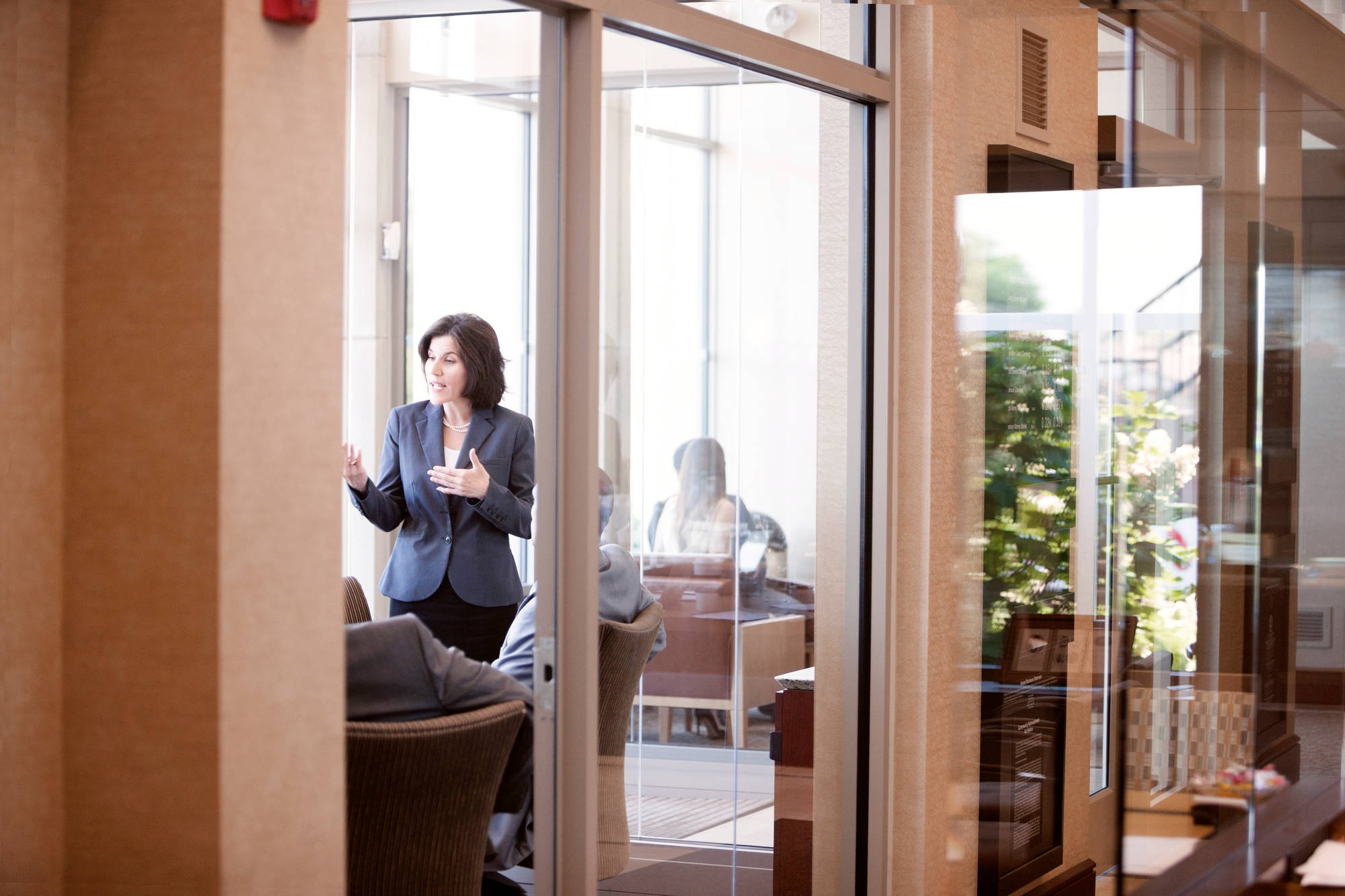-
Audit approach overview
Our audit approach will allow our client's accounting personnel to make the maximum contribution to the audit effort without compromising their ongoing responsibilities
-
Annual and short period audit
At P&A Grant Thornton, we provide annual and short period financial statement audit services that go beyond the normal expectations of our clients. We believe strongly that our best work comes from combining outstanding technical expertise, knowledge and ability with exceptional client-focused service.
-
Review engagement
A review involves limited investigation with a narrower scope than an audit, and is undertaken for the purpose of providing limited assurance that the management’s representations are in accordance with identified financial reporting standards. Our professionals recognize that in order to conduct a quality financial statement review, it is important to look beyond the accounting entries to the underlying activities and operations that give rise to them.
-
Other Related Services
We make it a point to keep our clients abreast of the developments and updates relating to the growing complexities in the accounting world. We offer seminars and trainings on audit- and tax-related matters, such as updates on Accounting Standards, new pronouncements and Bureau of Internal Revenue (BIR) issuances, as well as other developments that affect our clients’ businesses.
-
Tax advisory
With our knowledge of tax laws and audit procedures, we help safeguard the substantive and procedural rights of taxpayers and prevent unwarranted assessments.
-
Tax compliance
We aim to minimize the impact of taxation, enabling you to maximize your potential savings and to expand your business.
-
Corporate services
For clients that want to do business in the Philippines, we assist in determining the appropriate and tax-efficient operating business or investment vehicle and structure to address the objectives of the investor, as well as related incorporation issues.
-
Tax education and advocacy
Our advocacy work focuses on clarifying the interpretation of laws and regulations, suggesting measures to increasingly ease tax compliance, and protecting taxpayer’s rights.
-
Business risk services
Our business risk services cover a wide range of solutions that assist you in identifying, addressing and monitoring risks in your business. Such solutions include external quality assessments of your Internal Audit activities' conformance with standards as well as evaluating its readiness for such an external assessment.
-
Business consulting services
Our business consulting services are aimed at addressing concerns in your operations, processes and systems. Using our extensive knowledge of various industries, we can take a close look at your business processes as we create solutions that can help you mitigate risks to meet your objectives, promote efficiency, and beef up controls.
-
Transaction services
Transaction advisory includes all of our services specifically directed at assisting in investment, mergers and acquisitions, and financing transactions between and among businesses, lenders and governments. Such services include, among others, due diligence reviews, project feasibility studies, financial modelling, model audits and valuation.
-
Forensic advisory
Our forensic advisory services include assessing your vulnerability to fraud and identifying fraud risk factors, and recommending practical solutions to eliminate the gaps. We also provide investigative services to detect and quantify fraud and corruption and to trace assets and data that may have been lost in a fraud event.
-
Cyber advisory
Our focus is to help you identify and manage the cyber risks you might be facing within your organization. Our team can provide detailed, actionable insight that incorporates industry best practices and standards to strengthen your cybersecurity position and help you make informed decisions.
-
ProActive Hotline
Providing support in preventing and detecting fraud by creating a safe and secure whistleblowing system to promote integrity and honesty in the organisation.
-
Sustainability
At P&A Grant Thornton sustainability is at the core of our mission. We are committed to fostering a healthier planet through innovative practices that reduce our environmental footprint, promote social responsibility, and ensure economic viability for future generations.
-
Accounting services
At P&A Grant Thornton, we handle accounting services for several companies from a wide range of industries. Our approach is highly flexible. You may opt to outsource all your accounting functions, or pass on to us choice activities.
-
Staff augmentation services
We offer Staff Augmentation services where our staff, under the direction and supervision of the company’s officers, perform accounting and accounting-related work.
-
Payroll Processing
Payroll processing services are provided by P&A Grant Thornton Outsourcing Inc. More and more companies are beginning to realize the benefits of outsourcing their noncore activities, and the first to be outsourced is usually the payroll function. Payroll is easy to carve out from the rest of the business since it is usually independent of the other activities or functions within the Accounting Department.
-
Our values
Grant Thornton prides itself on being a values-driven organisation and we have more than 38,500 people in over 130 countries who are passionately committed to these values.
-
Global culture
Our people tell us that our global culture is one of the biggest attractions of a career with Grant Thornton.
-
Learning & development
At Grant Thornton we believe learning and development opportunities allow you to perform at your best every day. And when you are at your best, we are the best at serving our clients
-
Global talent mobility
One of the biggest attractions of a career with Grant Thornton is the opportunity to work on cross-border projects all over the world.
-
Diversity
Diversity helps us meet the demands of a changing world. We value the fact that our people come from all walks of life and that this diversity of experience and perspective makes our organisation stronger as a result.
-
In the community
Many Grant Thornton member firms provide a range of inspirational and generous services to the communities they serve.
-
Behind the Numbers: People of P&A Grant Thornton
Discover the inspiring stories of the individuals who make up our vibrant community. From seasoned veterans to fresh faces, the Purple Tribe is a diverse team united by a shared passion.
-
Fresh Graduates
Fresh Graduates
-
Students
Whether you are starting your career as a graduate or school leaver, P&A Grant Thornton can give you a flying start. We are ambitious. Take the fact that we’re the world’s fastest-growing global accountancy organisation. For our people, that means access to a global organisation and the chance to collaborate with more than 40,000 colleagues around the world. And potentially work in different countries and experience other cultures.
-
Experienced hires
P&A Grant Thornton offers something you can't find anywhere else. This is the opportunity to develop your ideas and thinking while having your efforts recognised from day one. We value the skills and knowledge you bring to Grant Thornton as an experienced professional and look forward to supporting you as you grow you career with our organisation.
Christmas is just around the corner. This is particularly true in the Philippines where come September, the holiday spirit is very much alive and felt. Months before Christmas, Filipinos start to put up Christmas trees and spruce up their homes with decorations. Malls and retailers add to the excitement by offering big sales that are oftentimes hard to pass up.
But for the second straight year, the way holidays are celebrated has changed. The pandemic has indeed ushered a new reality. When the pandemic struck, businesses had to be more agile and forward-looking. Accelerating digital transformation and making work-from-home arrangements work was placed on top of the list of business priorities. Consumers shifted their gaze to e-commerce and digital platforms, and this has since become a welcome development for companies engaged primarily in providing these services.
These changes, coupled with the imposition of lockdowns in certain areas in the country, contributed largely to the way consumers act. Gone are the days when shopping in malls was a good idea. Today, we see a shift in consumer behavior as an adaptive mechanism to health and travel restrictions imposed by the government to quell the spread of the COVID-19 virus.
Lockdowns amid a surge in COVID-19 cases – these are enough to dampen the holiday spirit, and businesses share the same sentiment. The retail real estate industry has borne the brunt of the pandemic and the decrease in number of shoppers in physical stores. The implications of the pandemic were wide scale. In terms of vacancy rate, Colliers International Philippines earlier forecast that the figure has reached 14%. This is comparable to vacancy rates recorded during the 1999 Asian Financial Crisis. Despite the reopening of some physical retail shops in the early part of 2021, the figures are still far from those posted before the pandemic. This is directly attributable to the public’s apprehension to go out of their homes to shop.
According to the Top 100 Retailers in Asia 2021 report by Euromonitor International, the retail industry is set to see sales return to pre-pandemic levels not by the end of this year, but by 2022. This is on the back of a delayed recovery in the Philippine retail industry which has seen a more slow-paced pivot compared with its Asian neighbors.
The Philippine Retailers Association also quipped that following a new round of lockdowns that have been imposed this year, it is pushing back positive projections on recovery at least until 2022. It cited that growth in the industry will probably be seen in 2023.
A few months before Christmas and amid another lockdown, consumers have become more in tune with purchasing holiday essentials online. This has put retailers with physical shops in a quandary as to how they can cut losses and improve sales.
New reality, new solutions
Property experts have provided a good idea for retailers operating physical shopping spaces. They propose converting these outlets into other facilities like co-working and data centers, or even micro-warehouses. By giving retail spaces alternative uses, occupancy rates can be improved. On the plus side, retailers can recover part of revenue losses. This is good news for shopping malls which can consider reconstructing a portion of their unused spaces for purposes other than traditional shopping outlets.
Go digital
They say that if you can’t join them, beat them. However, in this situation, if you can’t beat ‘em, you might as well join ‘em. Retail businesses may be guided by this new objective when it comes to boosting their digital presence alongside online businesses. As more consumers now opt to make purchases in the comfort of their homes, this new attitude has prompted businesses, old and new, to go virtual in their business transactions. People now prefer to buy from stores that have a strong online presence and those which use contactless and cashless transactions.
The trick is to go with the flow and adapt to changing consumer mindset - and going digital to boost sales is a good way to boost revenues. The growth in online transactions is also the main factor driving more people to put up their own online businesses. In fact, the Department of Trade and Industry (DTI) has intensified its e-commerce initiatives to help business owners, particularly Micro, Small and Medium Enterprises (MSMEs) to thrive in the new normal. Among them is the “Sugbo Negosyo” initiated by the provincial government of Cebu with the DTI and the Mandaue Chamber of Commerce and Industry (MCCI) as partners. In 2020, they organized a micro-business aid program which extended a helping hand to small businesses by giving them starting capital. This year, the Cebu provincial government, the DTI, and the MCCI organized an exhibit to showcase the products of the beneficiaries of last year’s program.
Another initiative, this time from the private sector, was rolled out early this year. The Davao City Chamber of Commerce and Industry (DCCCI) partnered with an e-commerce firm where the latter provided training on online selling to members of the DCCCI. The program also delved on basic principles in product photography and live-streaming, as well as effective market strategies. Another program will be held to include Davao-based businesses.
Boost omni-channel ventures
The e-commerce industry has seen a significant boost during the pandemic, and the retail industry can also reap the same benefits by tapping on e-commerce and streamlining their omnichannel strategies. In a nutshell, omnichannel marketing is a sales approach that aims to give consumers a more integrated shopping experience. It means making use of an organization’s different channels and platforms like physical stores and websites to support a seamless brand and product experience. The idea behind omnichannel marketing is that businesses must be able to catch the attention of consumers across different platforms by offering a consistent experience. This is because consumers are not just purely physical shoppers but virtual shoppers as well.
Businesses must first know their customers and from there, look at their spending habits and the channels they frequently use in making their purchases. Use data gathered in coming up with new strategies that can drive business growth. Also, it is crucial to choose the right marketing tools that can best implement new business strategies.
It’s just a few months before Christmas. While the light at the end of the tunnel is not yet in sight, organizations can turn the situation in the new normal around to their advantage. This can be done by adopting a new mindset and a host of improved strategies to catch the attention of consumers. For now, staying resilient and innovative is key. It’s just like the old saying which goes, “stop waiting for the light at the end of the tunnel and light it up yourself”.
As published in The Manila Times, dated 29 September 2021




